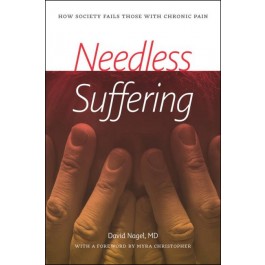Pain in the last few years has been a part of life. I do not talk about it that much because of the negative views people have on those suffering from pain. In David Nagel’s book “Needless Suffering” he takes us on a journey of the history of pain, what it means to be a pain doctor, a patient with pain, and the laws of what it means to medicate pain. I learned a lot.
When I read a book I have a notebook and pen with me and a highlighter so that I can mark things I want to talk about on my post. I marked 19 things that struck me as things I wanted to learn more about. I wrote out words I needed to look up to find out what the heck they meant. This book is an education and the best part is it wasn’t written boringly. One of the things I appreciate about Nagel is his love for people. The way he writes you can feel it in every sentence. I highly recommend that those of us who live with pain, who have a chronic condition that doesn’t get better read this informative book.
Since I wrote 19 things that intrigued me it is going to be hard for me to pick just 5 for this post. I will give it my all.
- Neural response to pain is not static, it changes constantly. That is why Chronic Pain is hard to manage successfully. I know this to be the truth, since dealing with my nerve pain since my lower back surgery. It changes, sometimes hourly, sometimes daily. It’s never the same all the time.
- PTSD in pain patients is a real thing. It needs to be considered when a doctor is treating the patient. The patient needs to consider it while going through the grieving process and all the things it takes to manage their pain. Recently, while talking with my counselor she suggested I could have PTSD from all of the trauma of having over 100 surgeries in the last 6 years on my throat. And having other medical issues that have left me fearful.
- There are 3 types of pain patients: Type A: have easily definable problems. Type B: have an overwhelming disability that severely compromises their function. Type C: have a medical problem that defies all medical explanation and does not respond appropriate, well-intended treatments. I believe I am a combination of type b and c. I have a rare illness that most doctors do not understand.
- The basic steps that a pain patient can do to avoid going downward spiral. 1. Recognize that they need to take control and responsibility to the extent of possible. 2. Learn to recognize passive and avoidance behaviors and to correct them. 3. Be physically, mentally, functionally, spiritually, and socially active in their own care. 4. Find a pain provider that they trust. I am happy that Stanford University offers a wonderful class called Living Well with Chronic Conditions. They talk about these things right here. If you haven’t take the free class I highly recommend it.
- Basic model for doctor-patient communication. 1. Passive model, the doctor does everything, and the patient accepts what is given. 2. Guidance cooperation model: the doctor makes a recommendation and the patient follows through. 3. Mutual participation model: the doctor and patient have a mutual exchange of ideas, generating hypotheses, setting goals, and measuring outcomes. From the beginning of my illness I made a decision that I was going to be an active participant in my wellness. It’s not easy. I really appreciate the doctors who allow me to have mutual participation in my own care.
There is so much great information in this book. Like I stated above I took a ton of notes while reading this book. I highly recommend that those of us with chronic illness get a copy of this book and perhaps, even share with our community and our doctors. It’s a great resource.
In exchange I was given a free copy of Needless Suffering by David Nagel MD from University Press of New England. The opinions I express are my own.






 Please wait...
Please wait...